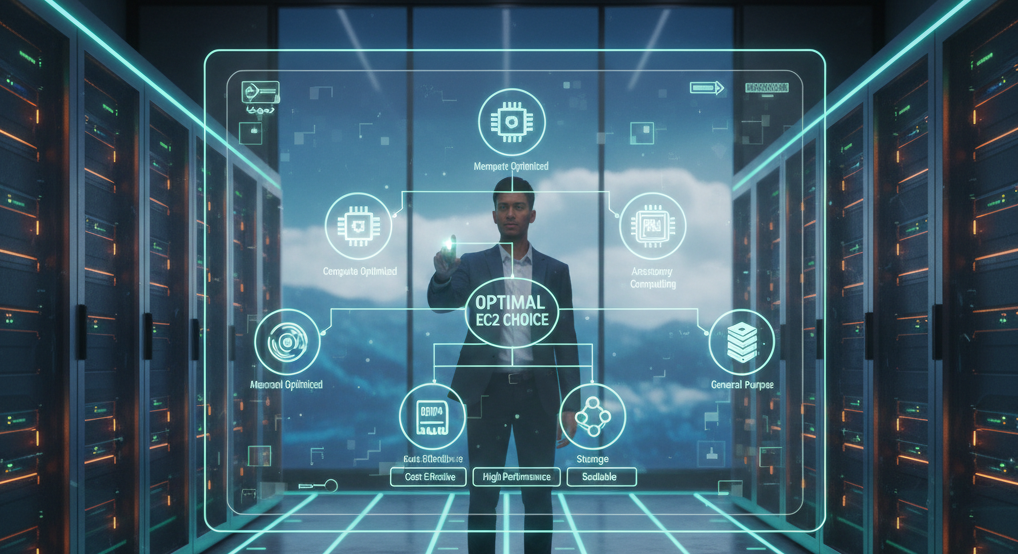The world of cloud computing has grown fast, with Amazon Web Services (AWS) standing out as a top provider. At its core, AWS offers Amazon Elastic Compute Cloud (EC2), a service that gives you scalable computing power. Think of EC2 instances as the engines powering countless applications and services in the cloud; they are truly the backbone of many modern online tools. Making smart choices here means your applications run well and your budget stays happy.
Picking the right EC2 instance can feel like looking for a needle in a haystack. AWS offers so many different types, it's easy to get lost. Choose the wrong one, and your app might run slow, or you could end up paying for power you don't even use. This guide will help you cut through the confusion, making it simple to find the perfect EC2 instance for your needs. We'll show you how to boost your application's speed and save money along the way.
Understanding EC2 Instance Families: The Building Blocks
Picking an EC2 instance starts with knowing the main groups, or "families." Each family is built for a different kind of job. Getting to know these basics will make your choice much clearer. You'll quickly see how each one might fit your project's demands.
General Purpose Instances (M, T Series)
General Purpose instances give you a good mix of CPU, memory, and network resources. They are like the all-around athletes of EC2. These instances work well for many common tasks, such as running web servers, handling small to medium databases, and hosting development environments.
- T-Series (Burstable Performance): T-instances provide a baseline level of CPU power but can burst to much higher levels when needed. This bursting uses something called CPU credits. They are great for websites with low traffic, testing environments, and small services that only get busy now and then. These instances offer a cost-effective choice for lighter workloads.
- M-Series (Balanced Performance): M-instances give you a steady, consistent level of CPU performance. They are perfect for apps that need reliable speed without big ups and downs. Many people use them for mid-level applications, serving applications, and even game servers. Your app will get a consistent amount of power, which helps prevent unexpected slowdowns.
Compute Optimized Instances (C Series)
These instances are built for heavy processing tasks. They offer high CPU performance and are ready for applications that need a lot of raw computing power. If your workload involves complex calculations, this is where you should look.
- C-Series (High CPU Performance): C-instances offer the best balance of price and performance for tasks that use a lot of CPU. You can use them for batch processing jobs, converting media files, high-performance computing (HPC), and even detailed scientific models. They are also a good choice for dedicated gaming servers that demand strong processing.
Memory Optimized Instances (R, X, Z Series)
Memory-optimized instances are designed for applications that need lots of RAM. They come with huge amounts of memory, making them ideal for tools that keep large datasets in memory. Think of tasks like in-memory analytics and powerful databases.
- R-Series (General Memory Optimized): R-instances offer a good mix of memory and computing power for apps that crave lots of RAM. They are often used for in-memory caches like Redis or Memcached, as well as for relational and NoSQL databases. Many businesses also use them for data analysis workloads.
- X-Series (High Memory): X-instances are for workloads that need truly massive amounts of RAM. If you run huge in-memory databases, like SAP HANA, or deal with big data analytics, these instances are a fit. They help with real-time processing of very large data sets.
Accelerated Computing Instances (P, G, F, Inf1 Series)
These instances use special hardware, called accelerators, to speed up specific tasks. They might have GPUs (graphics processing units), FPGAs (field-programmable gate arrays), or AWS Inferentia chips. These tools are perfect for jobs that can be broken into many small, parallel parts.
- P-Series (GPU Instances for ML/HPC): P-instances are made for demanding machine learning training and high-performance computing. Their powerful GPUs help with deep learning, complex scientific simulations, and detailed graphics rendering. These are the workhorses for cutting-edge AI.
- G-Series (GPU Instances for Graphics/Gaming): G-instances are optimized for applications that rely heavily on graphics. This includes game streaming, complex visual rendering, and machine learning inference tasks. They provide strong graphical processing power, making visuals smooth and fast.
Storage Optimized Instances (I, D, H Series)
Storage-optimized instances are built for fast access to data, with high data flow and quick response times. They come with local storage, which is great for big data projects and distributed file systems. Your data lives right on the instance for super-fast access.
- I-Series (High IOPS Storage): I-instances have high-performance local SSD storage. They are perfect for transaction-heavy databases, NoSQL databases, and data warehousing. These instances shine when you need to read and write data very quickly.
- D-Series (High Throughput Storage): D-instances give you large amounts of local storage, using traditional hard disk drives (HDDs). They are made for workloads that need to read and write large files in order, like distributed file systems or big data analytics. If your task is about moving lots of data sequentially, D-series is a great choice.
Key Factors for Choosing the Right EC2 Instance Type
Selecting the perfect EC2 instance means looking closely at what your application actually needs. You wouldn't buy a race car to haul groceries, right? The same idea applies here. Making a good choice can save you money and headaches.
Workload Requirements: CPU, Memory, and I/O
Start by looking at your application's resource usage. You need to understand how much CPU, memory, network, and disk I/O your app uses. Monitor your existing applications to spot any bottlenecks or patterns in resource use. For example, does your app use a lot of CPU but little memory? Or is it the other way around?
Actionable Tip: Use AWS CloudWatch metrics to understand your current resource consumption before selecting an instance. This data is key for informed decisions.
Network Performance and Bandwidth Needs
For applications that talk a lot to other services, or websites with lots of visitors, network speed matters a lot. Different EC2 instance types offer varying levels of network performance. Some even come with "Enhanced Networking" features for even faster data transfer.
Imagine a high-frequency trading platform. It absolutely needs instances with super-fast network throughput to keep delays as short as possible. Slow networks can directly impact your application's ability to perform.
Storage Requirements: Local vs. EBS
You have two main choices for storage with EC2: instance store and Amazon Elastic Block Store (EBS). Instance store is temporary storage right on the physical host server. EBS volumes, however, are network-attached and act like a virtual hard drive for your instance. You should pick between them based on how long you need data to last, how fast you need it, and how much it costs.
For critical data that needs to persist beyond the instance lifecycle, always opt for EBS volumes over instance store. EBS offers better durability and can be detached and reattached to other instances.
Cost Optimization Strategies
AWS offers several pricing models for EC2, helping you save money. You can pay On-Demand, which means you pay for compute capacity by the hour or second, with no long-term commitment. Reserved Instances let you commit to using an instance for 1 or 3 years, offering significant discounts. Savings Plans provide even more flexibility with similar discounts. Spot Instances let you bid on unused EC2 capacity, offering the largest savings but with a catch: AWS can take them back if it needs the capacity.
Many users find savings of up to 72% by committing to Reserved Instances or Savings Plans for their long-term compute needs. This means a big difference in your cloud bill.
Consider using AWS Cost Explorer to analyze your EC2 spending and identify opportunities for optimization. It helps you see where your money goes.
Advanced Considerations and Best Practices
Going deeper into EC2 choices can fine-tune your setup even more. Thinking about these advanced points helps you get the most out of AWS. It ensures your system is both powerful and budget-friendly.
Instance Families for Specific Workloads
Remember, each instance family is designed for a particular kind of job. A scientific research institution running complex simulations, for example, would definitely choose compute-optimized or GPU instances. These provide the massive parallel processing power needed for such heavy tasks. Matching the instance family to your app's core function is always a smart move.
Understanding vCPU, Memory, and Network Specifications
When you look at an EC2 instance, you'll see details like vCPU, memory in GiB, and network bandwidth. A vCPU is like a virtual core of a processor. Memory (GiB) tells you how much RAM the instance has. Network bandwidth describes how much data can move in and out of the instance. Knowing these numbers helps you pick an instance that truly meets your application's needs. AWS documentation provides great detail on how modern processor designs improve EC2 instances.
Graviton Instances: The Power of ARM
AWS Graviton processors use ARM-based chips instead of traditional x86 ones. These processors often give you better performance for your money for many workloads. They can be a great way to cut costs while keeping your applications fast. You should check if your software is compatible with ARM.
Benchmark your applications on Graviton instances to assess potential cost savings and performance gains. You might be surprised by the benefits.
Evaluating and Testing EC2 Instance Performance
Picking an instance is a good start, but the real test comes when your applications actually run on it. You need to make sure your choice performs as expected. This means doing some tests and keeping an eye on things.
Benchmarking Your Applications
It's smart to run tests on your applications using different EC2 instance types. This helps you see which one works best. Always test under conditions that are similar to what your application will face in the real world. This includes the number of users and the amount of data processed.
Utilize tools like Apache JMeter or Locust for load testing your applications on chosen EC2 instances. These tools can simulate many users at once.
Monitoring and Iterative Optimization
Choosing an instance type is not a one-time decision. Your application's needs can change as it grows or as user traffic shifts. You should always monitor your instances using tools like CloudWatch. This lets you see how your CPU, memory, and network are being used. If you see high usage often, it might be time to move to a more powerful instance. If usage is low, you might be able to downsize and save money.
Set up CloudWatch Alarms to notify you when key performance metrics (CPU utilization, memory usage) exceed predefined thresholds. This helps you react fast to issues.
Conclusion
Choosing the correct EC2 instance is a crucial step for any cloud user. We have covered key factors like your application's needs for CPU, memory, and I/O. We also looked at the different instance families, network demands, storage choices, and how to save money. Making smart choices helps your applications run better and keeps your costs in check.
Now, take action. Start by analyzing your current workloads to understand their exact needs. Don't be afraid to experiment with different instance types to see what works best. Then, put those cost-saving strategies into play. This approach will lead you toward more efficient and scalable cloud computing. By making informed EC2 instance choices, you ensure your applications perform well, grow easily, and stay within budget in the AWS cloud.

